
My favorite Mt.Fuji 10
Mt. Fuji is a strange mountain.
Recently, many people have come up to me with questions like “which one of your photographs of Mt. Fuji do you like best?” or “of all the views of Mt. Fuji you can see from different locations, which one is your favorite?”
I receive that kind of question so often.
And my answer is always, “the next one will be the best!”
I do not mean to sound sophisticated or anything, but that is how I truly feel.
After 3 years of taking photographs of Mt. Fuji, my imagination started to swell up and flow.
In what way?
I started envisioning scenes of Mt. Fuji that I would encounter next.
After looking at so many photographs, after observing so many meteorological phenomena, after scouting for so many shooting locations, and after making so many mistakes, images began to arrive.
The input of all that information into my brain began producing output.
“Imagination is more important than knowledge!”
That is what Einstein said.
Those words apply exactly to Mt. Fuji photography.
On the other hand, another aspect of Mt. Fuji photography is that, after taking more than ten pictures relying on the images that had arrived, you get only one good picture.
The intricate splendor of Mt. Fuji photography is in the fact that you occasionally encounter magnificent scenes unimaginable by the plain human.
You do not encounter such scenes often, but in the rare occasion that you do, The experience will exceed your highest expectation and immerse you in the deepest of emotions.
You will be allowed to catch a glimpse of the divine mystery of the universe.
Of the many scenes of Mt. Fuji I have encountered over the years, I have chosen ten that have impressed me particularly. There are different ways to select ten photos out of my collection. I will just say that these ten are among my favorites.
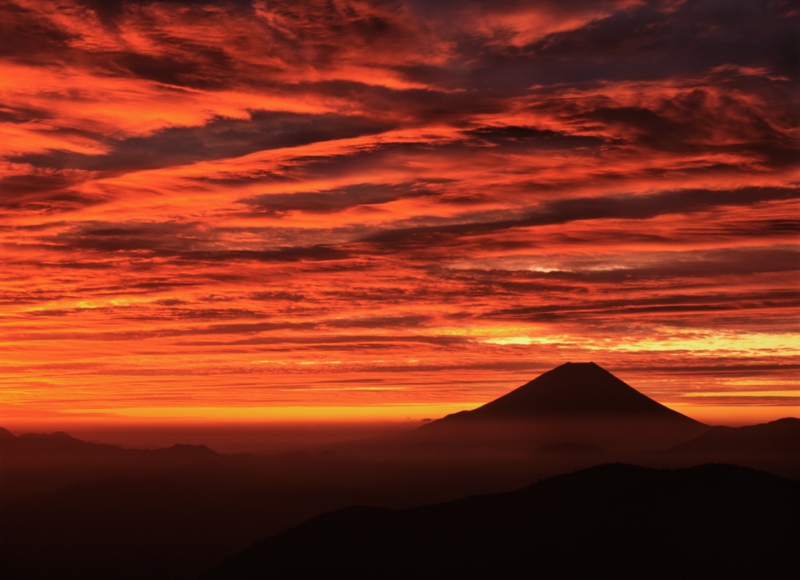
1. “Dawn Sky at Maruyama” Maruyama Forest Road, October
Driving past Asagiri and arriving at Lake Motosu, I examine the sky from the shore as usual. Clouds hang thick, and I would need to drive for more than an hour from here. After hanging around for about thirty minutes, I sit behind the driving wheel again. As I arrive at the planned shooting site, I am surprised that I am the only one there. In a short while, the signature silhouette of Mt. Fuji starts to appear against the thick black stripes of twilight. I had no way of knowing that the scene I was observing was soon to become a spectacle. On that morning, I would witness Mother Nature as never seen before and beyond any human imagination. My hands started shaking I could not change the roll of film in my camera. A minute seemed like an eternity. Standing before the majestic scene, I became but a shade of a tiny speck dissolving into the endless expanse of the universe.
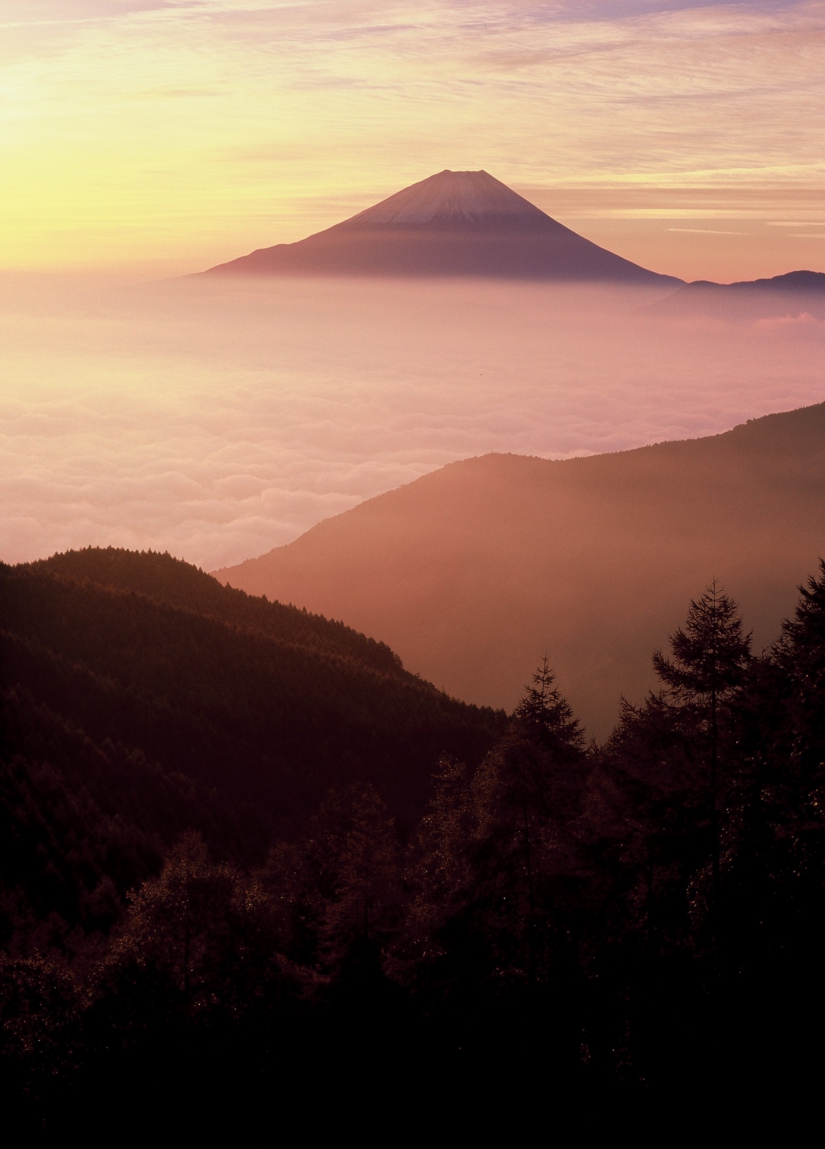
2. “Shining Light on a Sea of Clouds” Ikenochaya Forest Road, October
Felled timber is piled up in a heap. Between the cliff and timber is a gap where you can place a couple of tripods. This is the spot I like to station myself when shooting at this location. I get out of the car and carry my equipment. Using my free hand, I grab the edge of the timber protruding from the pile here and there, as I slowly step forward along the edge of the cliff. This is the spot where I tried so many times to get the right picture. On this particular morning, the clouds hanging low around the foothills of Mt. Fuji gave you a feeling that something was about to happen.
“It looks like it’s going to be a good day,” mumbled an old photographer close by. Sunrise approaches. As the temperature rises, the clouds begin to swell and slowly turn into an ocean that immerses the valley below.
“I won’t have a second chance!” I rehearse my routine of the shoot again as the moment of a lifetime approaches.
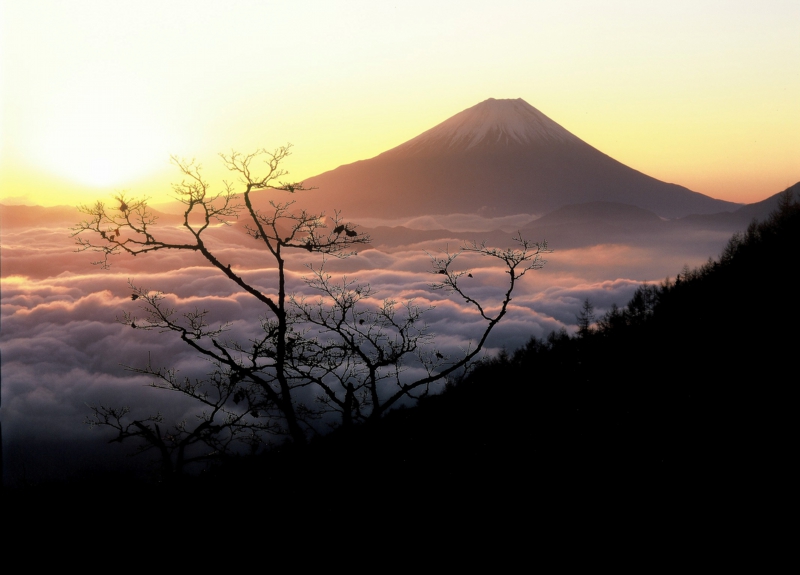
3. “Imagery of a Bare Tree” Kishigata Forest Road, November
At an exhibit I attended, I came across a photograph that had the same composition. For 3 years since, I visited this site repeatedly with an image, a certain imagery of a scene, in mind. The fog was thick at night, and you could not see anything. Many fellow photographers had given up and gone home. When the sun started to rise, the fog suddenly cleared, and the imagery of the bare tree appeared in front of me. The sea of clouds glowing in the morning light, the elegance of fresh snow, the sun shining brightly, and the bare branches of a tree in late autumn. These were the embodiment of the imagery I held inside.
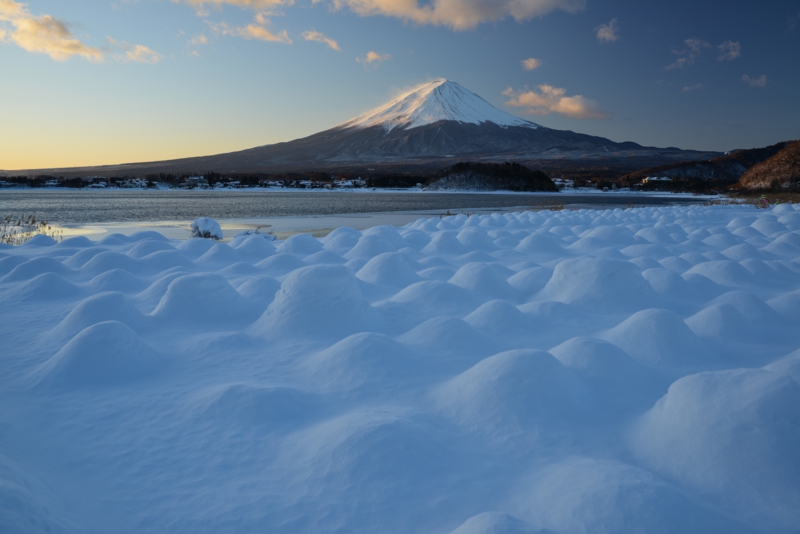
4. “Virgin Snow” Lake Kawaguchi, January
Clad in pure white like a bride about to wed,
I have never seen the world in such immaculate silver white.
A coincidence of nature happening once in several years, it is not unlike the providence of quantum correlation.
Like the sound of a beautiful melody, the image appears before you and then fades away.
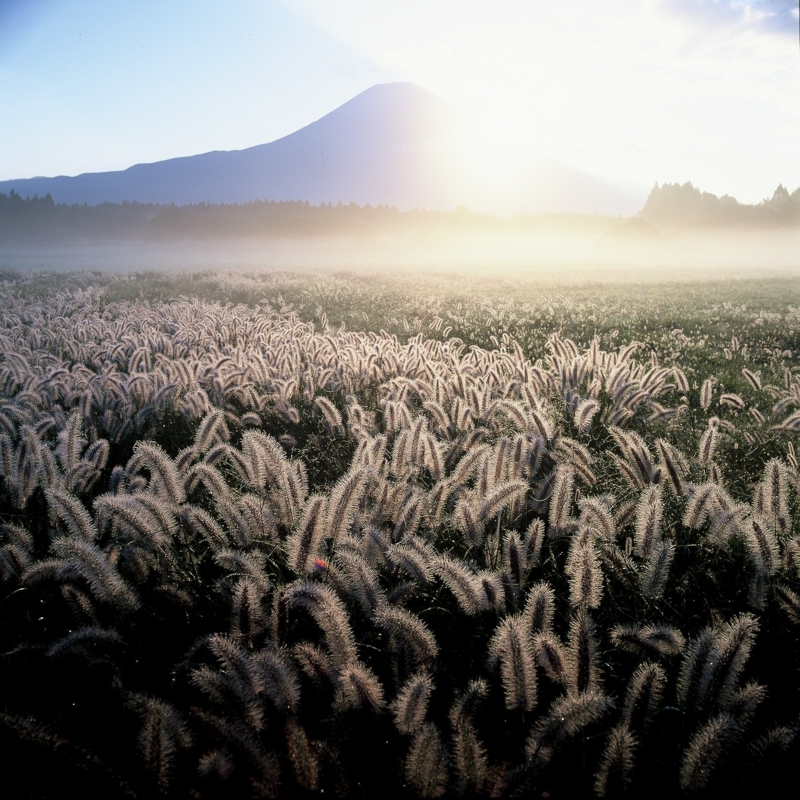
5.“Autumnal Setaria” Asagiri, October
Nekojarashi (Foxtail), also known as Enokorogusa in Japan: Enokoro means puppy in Japanese, since the seedhead resembles the tail of a puppy. You can observe this sight in late autumn, when the mornings become cold and the mist sets in. Around the time of year when the sun rises from the southern ridge of Mt. Fuji, the golden setaria reach full bloom and the morning dew that settles on it will sparkle under the morning sun. (Setaria is the Latin name of Enokorogusa.)
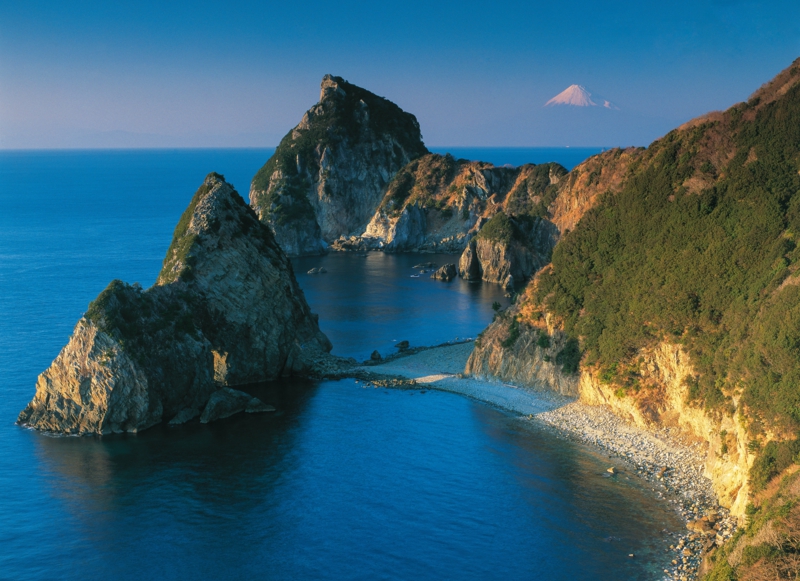
6. “Evening Calm at Senganmon” Senganmon, February
Senganmon is the secret treasure of western Izu. It is part of the microcosm surrounding Mt. Fuji.
From late December to late February, the sunset shines into the cove and creates a beautiful sight. During this time of year, when the Tohoku and Hokkaido areas are hit with heavy snow, the sea of Izu becomes rough as the low pressure system to the east evokes a roaring westerly wind.
On one February evening, I encountered an unusual sight; the evening calm at Senganmon. The cove was like a mirror, the water’s surface was so calm I could not believe my eyes, and the sacred mountain was gently watching over it. I felt as if I had once again witnessed the profoundness of Mother Nature.
“The spring sea rising
and falling, rising
and falling all day.”
<by Yosa Buson, Translation by Robert Hass>
All the best to Senganmon!
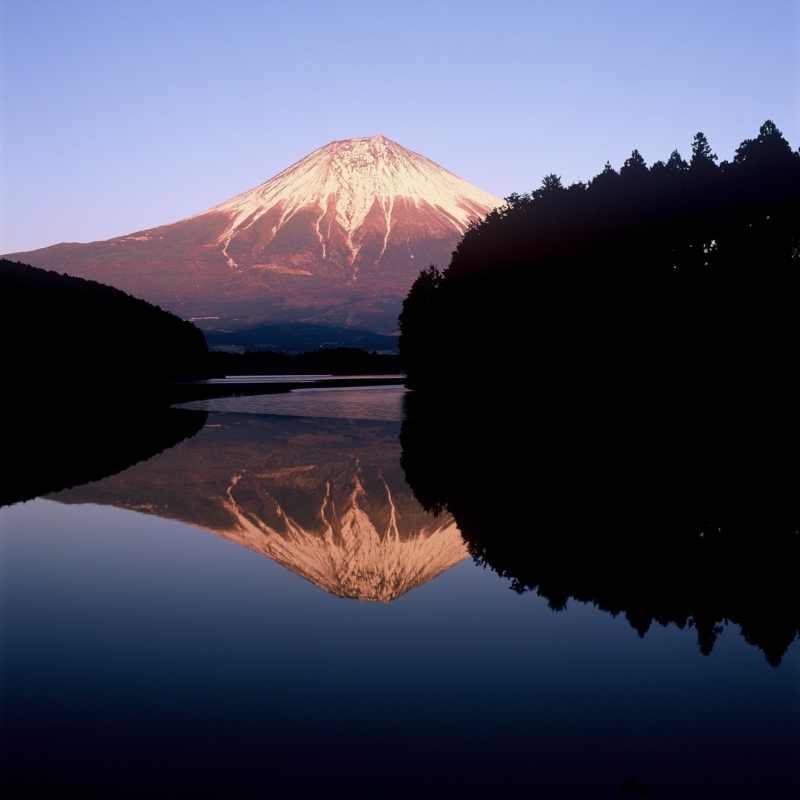
7.“Water Reflection” Lake Tanuki, February
This is a view from the crowded lakeside observation deck. Lake Tanuki became so famous for its view of the Diamond Fuji it now has become a destination for sightseeing bus tours. Photographers from all over Japan swarm to the site.
Apart from the famous Diamond Fuji that can be observed in April and August, the next most popular sight is the scene at dusk in February to early March. What is particularly breath taking is seeing the snow on Mt. Fuji change hue as it reflects the sunset, first to scarlet, then gold, then blue. If you are lucky, you can observe the Sakasa Fuji; the inverted reflection of Mt. Fuji on the lake.
The peaceful calm, the crisp silence, the leisurely flow of time; that precious moment, when nature and mankind become one and the same, slowly and quietly drifted away as if it were prompting you to search your soul and find out where you belong.
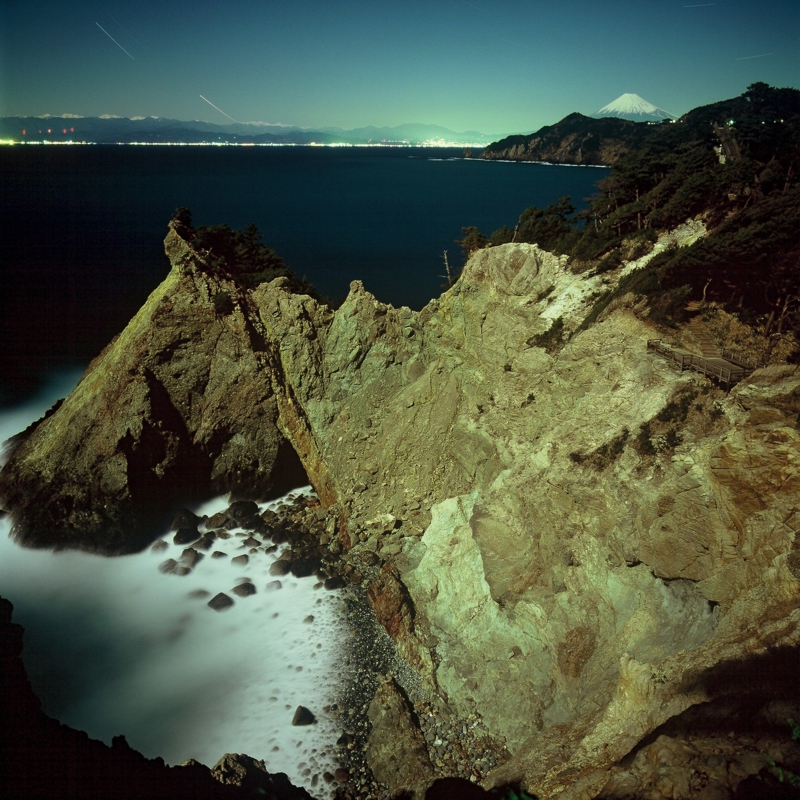
8. “Nocturne” Koganezaki, March
The cliffs of Koganezaki are made of propylite, a rock formed by the weathering of andesite. Its name originated from the golden color of the rocks reflecting the setting sun. (Kogane means gold in Japanese.)
I had been waiting for a chance to capture the colors of the cliffs under the moonlight, but was not successful due to the unseasonably warm weather that winter. Finally, on a night following some heavy rainfall, at around 3 a.m., the moon that had passed the meridian and begun its westward descent started to shine its light on the cliffs. The snow on Mt. Fuji could be seen by the naked eye.
“This is it!” I stand on the edge of a precipice and carefully set my camera. The propylite glowing under the moonlight, the sound of waves murmuring below, the faint green color of pine trees on the rocks visible in the darkness, the deep blue ocean, the crest of waves lapping the shores of the cape in the distance, the city lights, the mountain range of the Southern Alps, the path of the moving stars, and the tranquil Mt. Fuji.
It was like a nocturne performed late at night on a certain winter day in Izu.
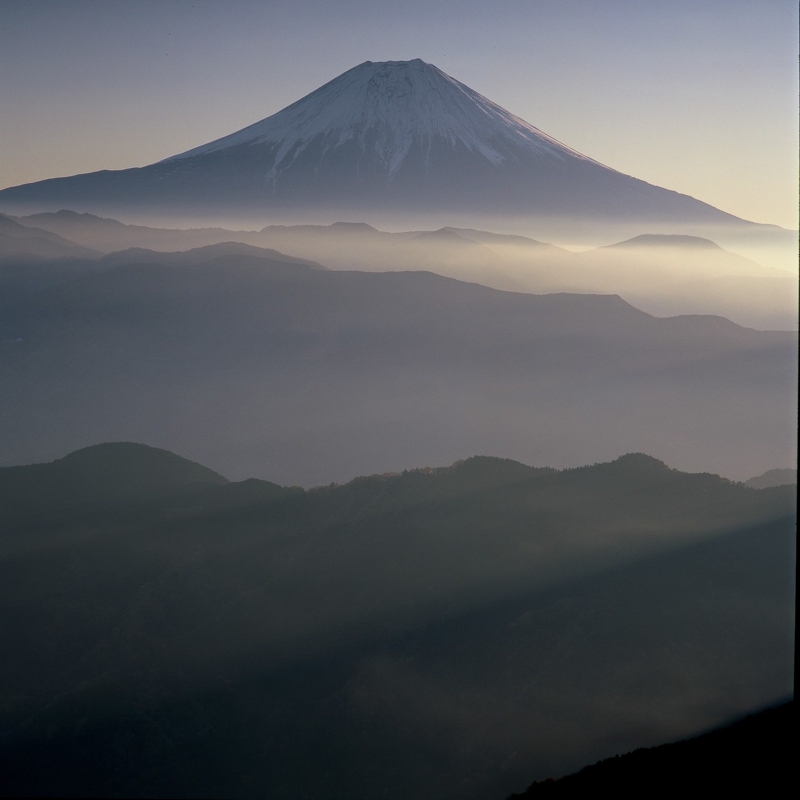
9. “Haze under Oblique Lights” Abe Pass, November
You are blinded by the glare of the ribbon of lights that penetrates the mountain side. Everything is but a haze under the oblique lights.
Here at Abe Pass in late autumn, the sun rises from the south, oblique lights illuminate the right-hand side of Mt. Fuji, and the beautiful mountain range in the foreground shines brightly. The Pass is close to Mt. Minobusan, which sits almost perfectly to the west of Mt. Fuji. On the vernal and autumnal equinoxes, the sun sets in the direction of the Western Pure Land (Buddhist Paradise).
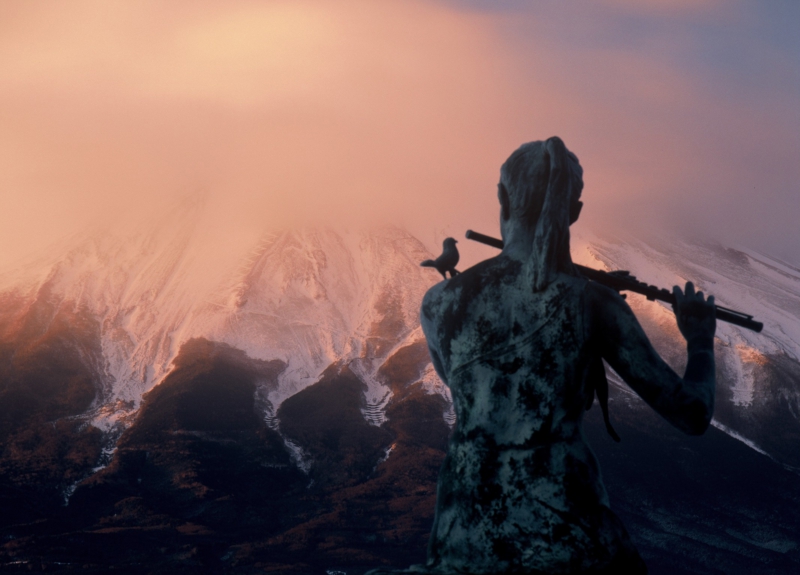
10. “To Live” Oshino, February
“The joy of life as a human being, becoming aware of that joy, those were the ultimate gifts that my illness brought me.” (Dr. Keiko Yanagisawa, life scientist)





